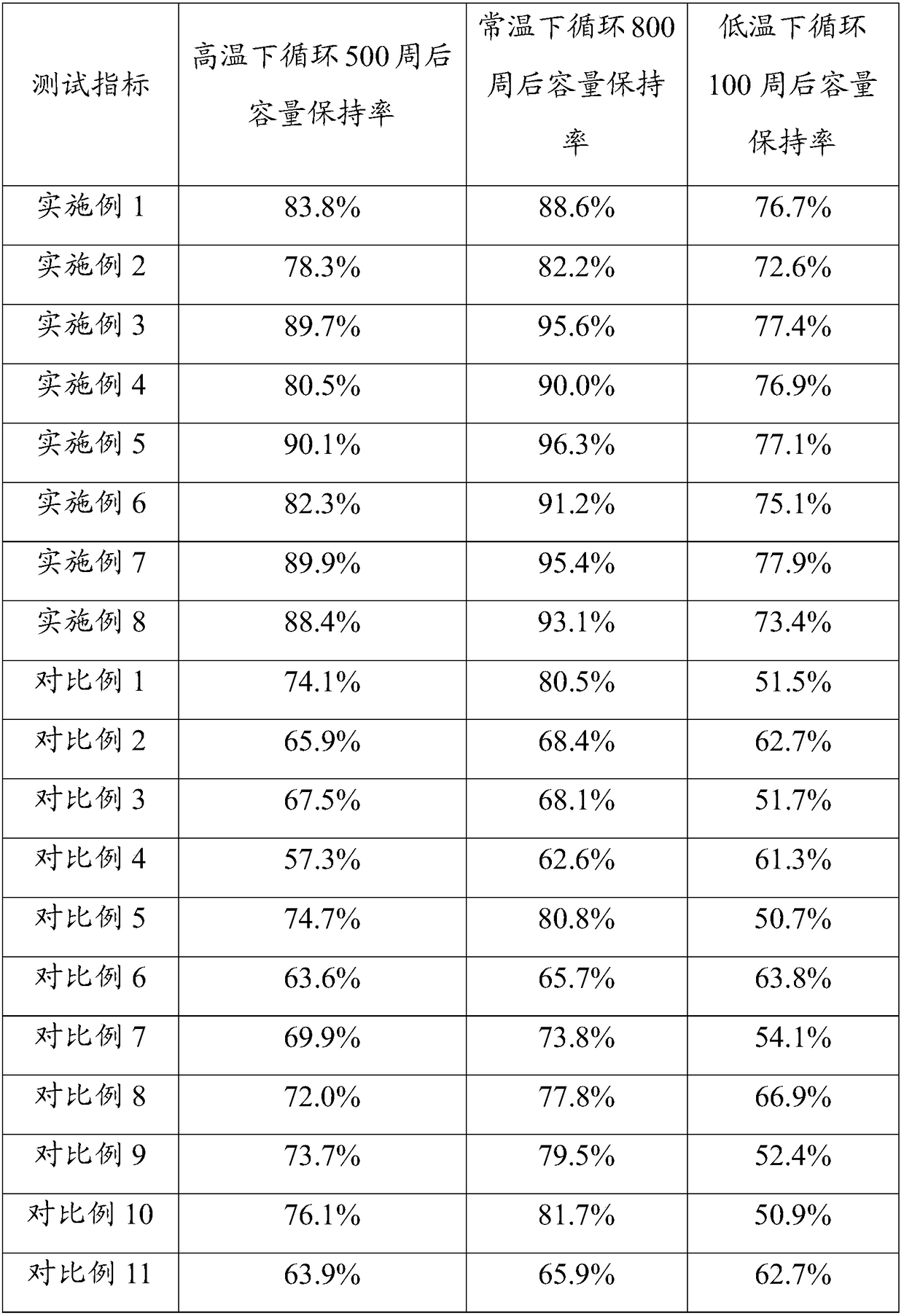Lithium secondary battery electrolyte solution and lithium secondary battery containing lithium secondary battery electrolyte solution
A lithium secondary battery, electrolyte technology, applied in secondary batteries, electrolytes, organic electrolytes, etc., can solve problems such as improvement and no disclosure of high temperature performance
- Summary
- Abstract
- Description
- Claims
- Application Information
AI Technical Summary
Problems solved by technology
Method used
Image
Examples
Embodiment 1
[0022] In this embodiment, an electrolyte solution for a lithium secondary battery is composed of an organic solvent, a conductive lithium salt, 1-ethyl-3-methylimidazolium tetrafluoroborate and additives. Described organic solvent accounts for 80.0% of the total mass of lithium secondary battery electrolyte, is made up of cyclic solvent (ethylene carbonate) and linear solvent (methyl ethyl carbonate), and the mass ratio of ethylene carbonate and methyl ethyl carbonate is 1 :1. The conductive lithium salt is lithium hexafluorophosphate, which accounts for 18.0% of the total mass of the electrolyte solution of the lithium secondary battery. 0.5% of the total mass of 1-ethyl-3-methylimidazolium tetrafluoroborate. The additives are lithium difluorophosphate and 2-propynyl methyl carbonate, respectively accounting for 1.0% and 0.5% of the total mass of the electrolyte. The electrolyte solution of this embodiment is used for LiNi 0.8 co 0.1 mn 0.1 o 2 / Graphite pouch battery....
Embodiment 2
[0024] In this embodiment, an electrolyte solution for a lithium secondary battery is composed of an organic solvent, a conductive lithium salt, dipyrrolidinyl ammonium tetrafluoroborate and additives. Described organic solvent accounts for 79.5% of the total mass of lithium secondary battery electrolyte, is made up of cyclic solvent (ethylene carbonate) and linear solvent (dimethyl carbonate), and the mass ratio of ethylene carbonate and dimethyl carbonate is 1 :2. The conductive lithium salt is lithium hexafluorophosphate, which accounts for 15.0% of the total mass of the electrolyte solution of the lithium secondary battery. The dipyrrolidinyl ammonium tetrafluoroborate accounts for 3.0% of the total mass of the electrolytic solution, and the additive is allyl methyl carbonate, which accounts for 2.5% of the total mass of the electrolytic solution. The electrolyte solution of this embodiment is used for LiNi 0.8 co 0.1 mn 0.1 o 2 / Silicon carbon pouch battery.
Embodiment 3
[0026] In this embodiment, an electrolyte solution for a lithium secondary battery is composed of an organic solvent, a conductive lithium salt, dipyrrolidinyl ammonium tetrafluoroborate and additives. Described organic solvent accounts for 77.0% of the total mass of lithium secondary battery electrolyte, is made up of cyclic solvent (ethylene carbonate) and linear solvent (diethyl carbonate), and the mass ratio of ethylene carbonate and diethyl carbonate is 1 :3. The conductive lithium salt is lithium hexafluorophosphate, which accounts for 12.0% of the total mass of the electrolyte solution of the lithium secondary battery. The dipyrrolidinyl ammonium tetrafluoroborate accounts for 10.0% of the total mass of the electrolytic solution, and the additive is lithium difluorophosphate, which accounts for 1.0% of the total mass of the electrolytic solution. The electrolyte solution of this embodiment is used for LiNi 0.6 co 0.2 mn 0.2 o 2 / Graphite pouch battery.
PUM
 Login to View More
Login to View More Abstract
Description
Claims
Application Information
 Login to View More
Login to View More - R&D
- Intellectual Property
- Life Sciences
- Materials
- Tech Scout
- Unparalleled Data Quality
- Higher Quality Content
- 60% Fewer Hallucinations
Browse by: Latest US Patents, China's latest patents, Technical Efficacy Thesaurus, Application Domain, Technology Topic, Popular Technical Reports.
© 2025 PatSnap. All rights reserved.Legal|Privacy policy|Modern Slavery Act Transparency Statement|Sitemap|About US| Contact US: help@patsnap.com


